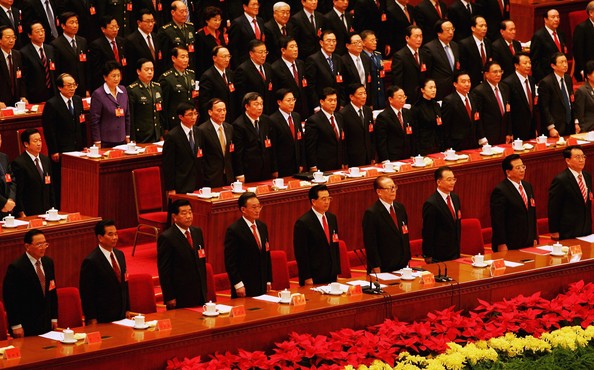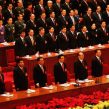
Chinese Analyses of Soviet Failure: The Party
Publication: China Brief Volume: 9 Issue: 23
By:

When Westerners examine the events of 20 years ago that led to the collapse of the Soviet Union—or even when they try to look at how China may change in the years ahead—their approach is very different from that officially followed in China today. Westerners almost without exception look instinctively for deep trends and deep causes—such things as rising literacy, increasing social complexity, or ethnic problems. Chinese officialdom approaches the dissolution of the Soviet Union in quite a different way.
Although much literature exists on the topic in China, not all of it is in accord with the official narrative that follows, and some of it at odds. What is addressed here is the most authoritative official analysis to date, which is interesting above all for the implications it has for future policy as China seeks to avoid the Soviet fate. It is an eight part television series called Preparing for Danger in Times of Safety—Historic Lessons Learned from the Demise of Soviet Communism (Ju’an siwei) [1].
As this essay will seek to make clear, today’s official China believes that nothing deep or fundamental was wrong with the Soviet Union even in the late 1980s. According to the Chinese official narrative, the failure of the Soviet regime to continue is not attributable to a broad systemic phenomenon, but rather to a very specific failure of the Communist Party of the Soviet Union.
This viewpoint is becoming very clear as the first fruits of the nearly decade-long research program that examine the events mentioned are made public. The Chinese authorities distinguish clearly between two events that Westerners tend to merge: the first, as they see it, is a failure of the communist party of the Soviet Union and consequent loss of authority with the second, which is the result of the first, being the disintegration of the Soviet Union.
This negative evaluation of Soviet party policy is a post-1989 phenomenon. A perusal of Beijing Review for the Gorbachev years before that date will reveal much more positive and optimistic coverage, which began to diminish after Li Peng became premier in April 1988 [2].
After the collapse, the year 2000 saw the establishment in the Chinese Academy of Social Sciences of research groups devoted to two topics: one to the strength and decline of the Soviet Communist Party and the other the rise and fall of the Soviet Union. The work of these groups was considered so important that it was subsequently designated a “fundamental national social science research topic” and other organizations were brought into the work, including the National Party Construction Committee and the Central Disciplinary Committee [3].
The result was what Westerners may consider the most authoritative official Chinese assessment of the end of the Soviet Union to date. This film focuses not on world events, or on general trends in the socialist world, but rather on the details of the history and policies of the Soviet communist party—presented with an orthodox purity one might have expected in the 1940s. The message is that the Soviet party failed because it gave up the dictatorship of the proletariat, ceased to practice democratic centralism, criticized Stalin, was beguiled by western concepts such as democracy, and also tripped up by Western propaganda and other operations.
The series begins by listing some possible causes for Soviet collapse such as “lack of flexibility within the Stalinist model” and the “betrayal of Gorbachev” but then asks:
[W]hat is the most fundamental cause? Comrade Mao Zedong once told us that ‘if there are multiple conflicts within any process, there must exist one major conflict that plays the leading and decisive role.’ In his famous 1992 talks in the South, Comrade Deng Xiaoping clearly pointed out ‘If problems are to occur, they are bound to occur inside the CCP [Chinese Communist Party].’ In December 1991, Comrade Jiang Zemin pointed out that the transformation of the former Soviet Union and Eastern European countries is not due to the failure of Scientific Socialism [emphasis supplied] but to the abandonment of the Socialist path. In December 2000, Comrade Hu Jintao also pointed out that there are multiple factors contributing to the disintegration of the Soviet Union, very important ones being Khrushchev throwing away Stalin’s knife and Gorbachev’s open betrayal of Marxism-Leninism’ [3]. The Introductory segment concludes: “What went wrong? It is found in the CPSU” [Communist Party of the Soviet Union] [4].
What exactly went wrong in the CPSU? According to official interpretation, most importantly, the party ceased to insist that it was the sole ruling party, seeking instead to bring society in as its own ultimate governor.
To explain this historically, the film turns to the Second Congress of the Russian Social Democratic Labor Party (Brussels and London) where 190 of Lenin’s “Bolsheviks” insisted on party dictatorship [5]. Yet theirs was a view not shared by all socialists or communists. Marx and Engels were vague about the “dictatorship of the proletariat” seeing it as a transitional mechanism that would be unnecessary in a socialist society where contradictions had ceased to exist [6]. With the idea of a permanent ruling party went the idea that it would make its decisions according to the procedures of “democratic centralism” of which Lenin is the great exemplar.
At the center of the presentation is a most favorable presentation of Stalin. As the narrator states, while images of impressive industrial development and prosperous farmers fill the screen, “From April 1923 to March 1953 Stalin . . . held the country’s top leadership positions . . . This was a thriving and prosperous period of time in the history of the CPSU and the Soviet Union. During this period, the speed of Soviet’s social and economic development and growth of its overall national power greatly exceeded that of the capitalist countries . . . The Soviet Union during Stalin’s time announced to the world the incomparable superiority and vitality of the new socialist system” [7].
Some lip service is paid to the idea that Stalin made errors, including “expansion of his purges, as well as the bitter fruits of his non-democratic working style and the mistakes caused by his abusive manner.” But these are minor. As the narrative concludes, "[A]s time goes by, when we brush off the dust of history, people feel more than ever that Stalin’s errors should never tarnish his position as a great Marxist and proletarian revolutionist in history” [8].
In particular, the figures commonly given for deaths under Stalin are ridiculed and diminished: “Wild exaggeration” took place of “the number of people killed in Stalin’s purges of counter-revolutionaries. The number was exaggerated several dozen times to reach 10 million or tens of millions” [9].
If Lenin and Stalin are the heroes of the piece, Khrushchev and later Gorbachev are most emphatically the villains.
At the 20th Congress of the CPSU, February 14, 1956 First Secretary Khrushchev made a presentation of a secret report called “On Personal Worship and its Consequences”—the “secret speech” which detailed Stalin’s true record [10].
As bad as Khrushchev’s denunciation of Stalin was his attempt to change the nature of rule in the USSR. The platform that was passed by the 22nd Party Congress in October 1961 stated, “The Proletarian Dictatorship is no longer necessary in the Soviet Union. At its new stage, or this stage, the country, born as a country of Proletarian Dictatorship, has become a State of the People” [11]. With this quasi-democratic idea taking the place of dictatorship, the rot set in, particularly in the younger generation.
Young people in the CPSU grew up under Khrushchev’s influence at the 20th Congress’s criticism of Stalin. They were unfamiliar with the party’s revolutionary tradition, and lacked firm beliefs in socialism. They were later known as “the babies born at the 20th Congress.” After the mid-80s of the 20th century, it was exactly these people who became the backbone that disintegrated the CPSU and buried the socialist system [12].
In 1964, Brezhnev and his associates ousted Khrushchev, which is presented as a positive development in the documentary. This is not least because in June 1967 the CPSU’s Central Committee passed a resolution that restored some of the concept of the dictatorship of the proletariat, stressing that the ‘State of the People’ still had a class character and would ‘continue the cause of the Proletarian Dictatorship.’”
Yet after Brezhnev’s death in 1982, “Andropov and Chernenko passed away in three years” and in March 1985 Gorbachev came in bringing slogans of “democratization,” “openness,” and “media diversity” [13].
Gorbachev’s ideals are seen as a continuation of Khrushchev’s quasi-democratic concept of the “state of the people.” Gorbachev’s memoirs are quoted as follows:
If you try to succinctly sum up the idea of political reform, then the thinking and implementation can be summarized as to transfer power from the monopoly of the Communist Party’s hands to the hands of the people who are entitled to enjoy it through the Constitution, or to the hands of Soviets comprised of freely elected representatives [14].
Such ideas led to the amendment of the Soviet Constitution in 1991 to allow political freedom—and the collapse of any vestige of proletarian dictatorship or democratic centralism as “20 parties were formed in one year at the Union level and 500 at the Republic level” [15].
All of this is very different from the standard Western analyses of the Soviet failure. To be sure, the authors allow that between the time of Stalin and Brezhnev the Soviet Union began to lose its leading place among the nations of the world:
“In the 1960s, the capitalist world’s electronic, information, biological, and other science and technologies had made great progress but the Soviet Union was lacking timely knowledge of the world’s scientific and technological revolution” [16].
But the situation could have been salvaged, perhaps if the Soviets had adopted the path subsequently followed by China.
If the ruling Communist Party could have adhered to Marxist-Leninist theory and paths, timely and correctly solve the accumulated problems and conflicts, and correct the mistakes with courage, it would have been possible to pull the Soviet Union and the Communist Party out of danger, and to continue to push the socialist cause forward [17].
Such is the Chinese official—it must be stressed official—diagnosis of the Soviet failure, and from the diagnosis will flow the policy solution. Perhaps it is not surprising, then, that party discipline and unity are at the top of the list of issues being stressed publicly in China today, and simple repression is regularly employed as a means of dealing with tensions, while relatively less emphasis is placed on how to cope with the vast challenges posed to any authoritarian government by a dynamic, growing, and ever-differentiating society. [To be continued]
Notes
1. Ministry of Education, 2/20/2009. The Chinese text is now available on the internet at chinaelections.org, while a Chinese-English transcript, upon which this essay draws with modifications [“Transcript”], is available at chinascope.org. In addition, CDs of the entire series circulate unofficially; one is in the possession of the author.
2. See Arthur Waldron, “The Soviet Disease Spreads to China” Far Eastern Economic Review 172.8 (October 2009), pp. 24-27.
3. Preparing for Danger in Times of Safety—Historic Lessons Learned from the Demise of Soviet Communism. Ministry of Education, 2/20/2009.
3. Transcript, p. 1.
4. Transcript, p. 13.
5. Transcript, p. 5.
6. See “Dictatorship of the Proletariat” in Tom Bottomore, et al, eds. A Dictionary of Marxist Thought (Cambridge, Mass: Harvard University Press, 1983) pp. 129-131.
7. Transcript, p. 8.
8. Ibid.
9. Transcript, p. 28.
10. Transcript, p. 8.
11. Transcript, p. 18.
12. Transcript, p. 8.
13. Transcript, p. 19.
14. Transcript, p. 9.
15. Transcript, p. 22.
16. Transcript, p. 10.
17. Transcript, p. 20.
[The first of an occasional series on how China views the collapse of the Soviet Union.]





